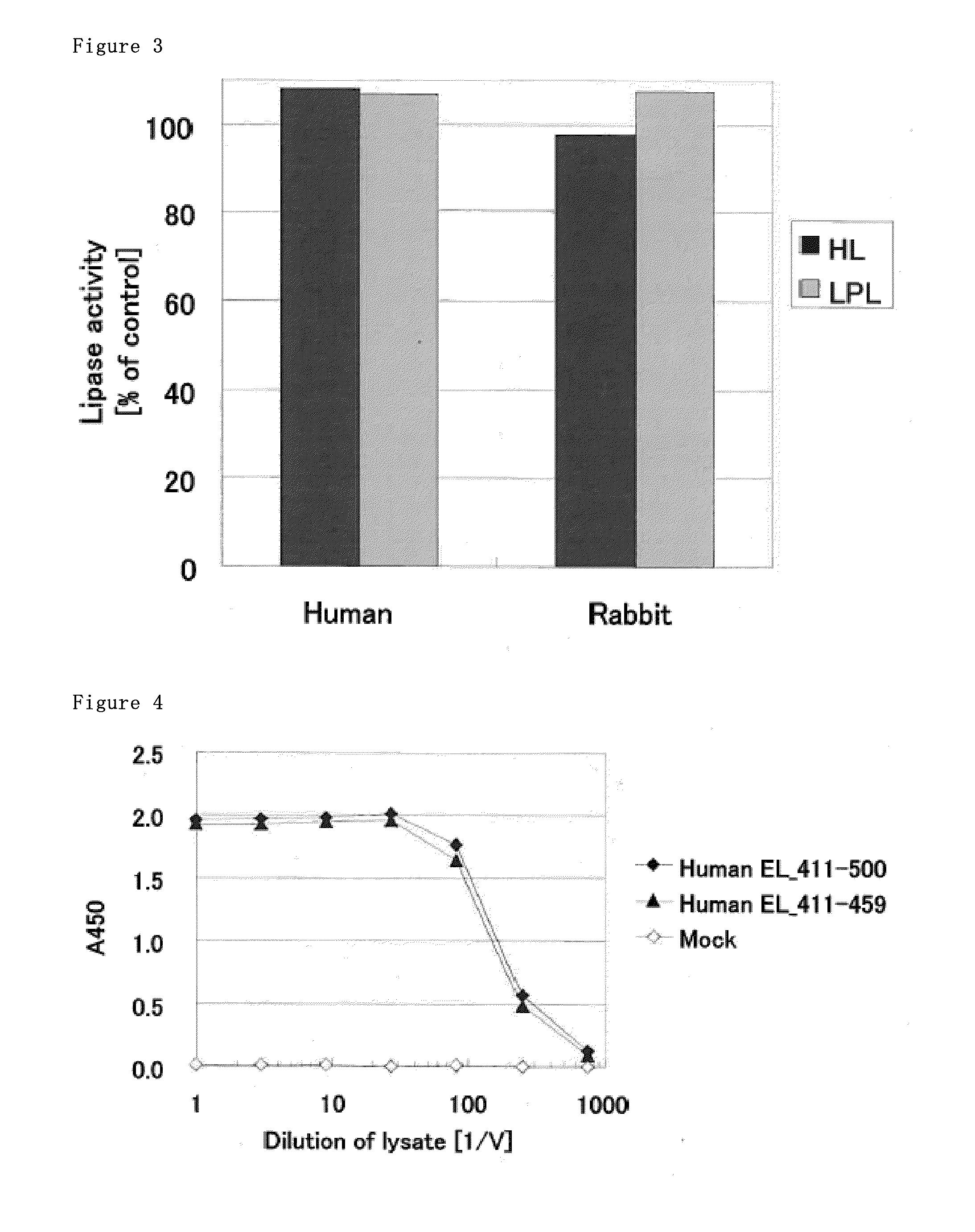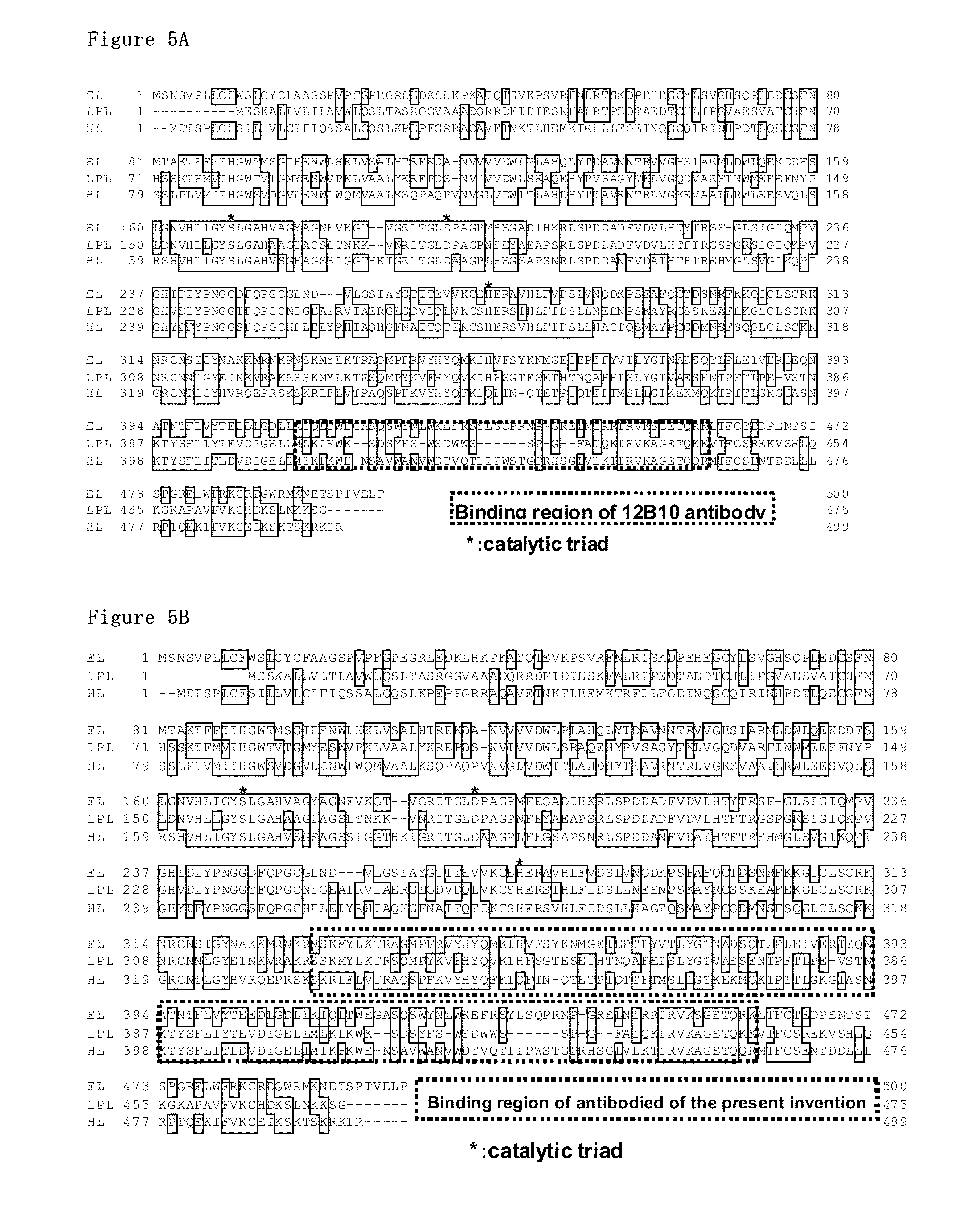Monoclonal antibody against el which inhibits enzyme activity of el
a monoclonal antibody and enzyme activity technology, applied in the field of monoclonal antibodies, can solve the problems of difficult manipulation of the immunogenicity of polyclonal antibodies, inability to use rabbit anti-el polyclonal antibodies, etc., and achieve the effect of selective inhibition of enzyme activity and prevention
- Summary
- Abstract
- Description
- Claims
- Application Information
AI Technical Summary
Benefits of technology
Problems solved by technology
Method used
Image
Examples
example 1
Preparation of Recombinant Adenovirus to Express Human EL
[0159]The cDNA of human EL with C2 tag (SEQ ID NO: 3) was cloned into pShuttle vector (Clontech). This sub-cloned vector and the vector carrying adenoviral backbone gene was digested by PI-SceI and I-CeuI enzyme (Adeno-x Accessory Kit, Clontech). The ligation reaction of the digested fragments was conducted at 16° C. for 3 hrs (Ligation high, TOYOBO) and the ligation products were transformed to E. coli (OneShot stb13 Chemically Competent, Invitrogen). After selection of Ampicillin, plasmid DNA was purified from obtained clone (QIAprep spin Miniprep Kit, QIAGEN) and was digested by PacI enzyme to cut E. coli growth area (New England Biolabs). With the above, plasmid DNA was acquired to generate adenovirus vector. Acquired plasmid DNA was transfected to HEK293 cells (dispensed from human science promotion foundation) using Lipofectamine 2000 (Invitrogen) and cultured in DMEM containing 10% FBS at 37° C. After transfection, we c...
example 2
Preparation of the Cells that Express Human EL and Human EL Lysate
[0160]We added C2 tag (SEQ ID NO: 3) to 3′ end of DNA encoding human EL, added the DNA fragment to pcDNA3.1 (Invitrogen) using restriction enzyme site of HindIII and XbaI, constructed expression plasmid that expressed EL to prepare human EL-C2 tag. The human EL expression vector was transfected into HEK293 cells with Lipofectamine-2000 (Invitrogen). After 48 hr culture, HEK293 cells were collected and used as human EL-overexpressed cells. The cells were lysed with Lysis buffer containing 1% TritonX-100, 100 mM NaCl and 25 mM Tris / HCl (pH8.0). The supernatant was collected using centrifugation and used as human EL lysate. The rabbit EL lysate was prepared in the same method.
[0161]The amino acid sequence of human EL-C2 tag was described in SEQ ID NO: 1 and that of rabbi EL-C2 tag was described in SEQ ID NO: 2.
example 3
Preparation of Human EL Fragment 411-500 (SEQ ID NO:4) and 411-459 (SEQ ID NO:5)
[0162]We added his tag to 5′ end of cDNA containing amino acids that positioned 411 to 500 in amino acid sequence of SEQ ID NO: 1 and C2 tag to 3′ end end of cDNA containing amino acids that positioned 411 to 500 in amino acid sequence of SEQ ID NO: 1, this was cloned into expression vector pcDNA3.3 (Life technologies), and used as human EL—411-500 fragment expression vector. We prepared human EL—411-459 fragment expression vector in the same method. Each expression vector was transfected into HEK293 cells using Lipofectamine 2000 (Life technologies). After culturing for 48 hours, the cells were lysed with Lysis buffer (25 mM Tris / HCl, pH8.0 containing 1% TritonX-100 and 100 mM NaCl). After centrifugation, the supernatant was collected. The supernatant were used as human EL—411-500 fragment lysate and human EL—411-459 fragment lysate.
PUM
| Property | Measurement | Unit |
|---|---|---|
| pH | aaaaa | aaaaa |
| temperature | aaaaa | aaaaa |
| total volume | aaaaa | aaaaa |
Abstract
Description
Claims
Application Information
 Login to View More
Login to View More - R&D
- Intellectual Property
- Life Sciences
- Materials
- Tech Scout
- Unparalleled Data Quality
- Higher Quality Content
- 60% Fewer Hallucinations
Browse by: Latest US Patents, China's latest patents, Technical Efficacy Thesaurus, Application Domain, Technology Topic, Popular Technical Reports.
© 2025 PatSnap. All rights reserved.Legal|Privacy policy|Modern Slavery Act Transparency Statement|Sitemap|About US| Contact US: help@patsnap.com



